Dell 2407WFP and 3007WFP LCD Comparison
by Jarred Walton on March 2, 2007 11:30 AM EST- Posted in
- Displays
Dell 3007WFP: Appearance and Design
The 3007WFP is almost a direct clone of the 2407WFP, at least in terms of the outward appearance. It's basically the big brother -- and we definitely mean BIG! Most users already think that a 24" LCD is pretty large, but the 2407WFP is absolutely dwarfed by the 3007WFP.
Other than the change in size, most of our commentary about the 2407WFP applies to the 3007WFP. It's attractive and it comes with a base stand that allows a reasonable amount of travel (about four inches).
You get tilt, swivel, and height adjustment courtesy of the base stand. If you prefer, you can also remove the base stand and use a standard 100mm VESA wall mount. Unlike the 2407WFP, there's no ability to rotate the display. Considering the size of the panel, that is to be expected -- you would need a base stand with about six inches of vertical travel to even be able to accommodate the increased height of portrait mode.
The rear of the display is relatively nondescript, but all of the connection ports are facing downwards so they aren't immediately visible.
As far as input ports go, as mentioned earlier only a single DVI port is present and the display requires a dual-link capable graphics card in order to run at its native 2560x1600 resolution. The 3007WFP can still function as a USB hub, and the USB input as well as two USB ports are located on the back of the display. Besides the main power connection, a power socket for an optional speaker bar is once again present.
Like the 2405FPW and 2407WFP, the left side provides two additional USB ports along with a flash memory reader. The same flash memory types as the 2407WFP are supported via the 9-in-2 reader.
Describing the On-Screen Display for the 3007WFP is extremely simple: there is no OSD! At the bottom of the display are three buttons: power, increase brightness, and decrease brightness. There are 20 levels of backlight intensity, but there's no immediate indication of your current setting. This is definitely taking minimalism to an extreme, and while many of the other features usually present in an OSD are unnecessary considering there is only one video input available, we really would have liked to see at least a few more options.
Speaking of options, we would also really like to see more video input choices. Granted, no analog signals are going to be capable of driving 2560x1600 resolution without experiencing signal degradation, but the 3007WFP does a good job at scaling non-native resolutions so it still should have been possible to include a VGA connection as well as component inputs and simply limit the maximum resolution with those connections to 1920x1200. We would also really like to be able to run single-link DVI at resolutions above 1280x800.
As it stands, the 3007WFP is intended pretty much only for use with a computer. Considering a 30" LCD is larger than a lot of people's televisions, it seems a shame to limit the versatility of the display.
30 Inch vs. 24 Inch
Having used both of these LCDs for a while, we felt it might be useful to provide our impressions of the experience. We used 21" CRTs for a long time, but the upgrade to a 24" LCD still broght noticeably more screen area. Personally, I held out switching to LCDs due to concerns about refresh rates and pixel response times, but when I finally upgraded to a 24" LCD (the 2405FPW), I was extremely pleased with the result. Some people still have complaints about LCDs versus CRTs, but overall we feel the benefits far outweigh the negatives and all of us are more than happy using LCDs on a daily basis.
If a 24" LCD feels pretty large compared to a 21" CRT (despite the fact that it weighs about one third as much), a 30" LCD is absolutely huge. Provided your eyesight is good enough, you almost feel the need to sit back several feet further away from the computer. Of course, the native resolution is such that icons and text are actually slightly smaller than what they would be on a 24" LCD, and if you end up sitting close to the screen like most people a 30" LCD can almost feel too big.
Another potential problem with such large LCDs is that they can require a ton of graphics power in order to run games at their native resolution. A single fast graphics card like a Radeon X1900 XT is generally sufficient for running most modern games at 1920x1200, but until the launch of the GeForce 8800 series it simply wasn't practical to play most games at 2560x1600 without dual GPUs. Even if you've got the graphics horsepower, configuring some games to run at the native resolution can be a pain, although thankfully this is getting better with time.
24" LCDs are pretty expensive still, and 30" LCDs are even more so, so before going out and spending a lot of money on a large LCD you will definitely want to try one out in person. Provided you have the hardware, using a 30" LCD is a really enjoyable experience for gaming and multitasking, at least from our perspective. Not everyone feels that way, however, and considering the price we feel that the 22"-26" LCDs are currently the sweet spot. You could purchase two 24" LCDs for the price of a 30" LCD right now, and there are also plenty of desks where it simply isn't practical to try and use a 30" display. If you've got the money and desk space, however, a 30" LCD definitely won't disappoint -- it just might take a little time to get used to having such a huge monitor.
The 3007WFP is almost a direct clone of the 2407WFP, at least in terms of the outward appearance. It's basically the big brother -- and we definitely mean BIG! Most users already think that a 24" LCD is pretty large, but the 2407WFP is absolutely dwarfed by the 3007WFP.
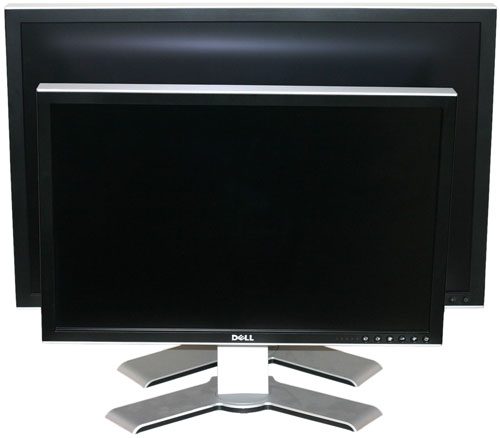 |
| Click to enlarge |
Other than the change in size, most of our commentary about the 2407WFP applies to the 3007WFP. It's attractive and it comes with a base stand that allows a reasonable amount of travel (about four inches).
 |
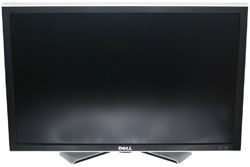 |
| Click to enlarge | |
You get tilt, swivel, and height adjustment courtesy of the base stand. If you prefer, you can also remove the base stand and use a standard 100mm VESA wall mount. Unlike the 2407WFP, there's no ability to rotate the display. Considering the size of the panel, that is to be expected -- you would need a base stand with about six inches of vertical travel to even be able to accommodate the increased height of portrait mode.
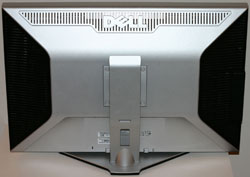 |
| Click to enlarge |
The rear of the display is relatively nondescript, but all of the connection ports are facing downwards so they aren't immediately visible.
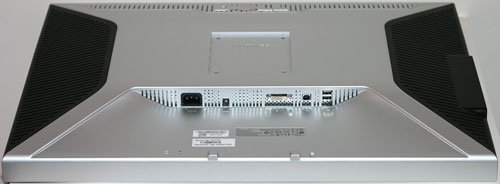 |
| Click to enlarge |
As far as input ports go, as mentioned earlier only a single DVI port is present and the display requires a dual-link capable graphics card in order to run at its native 2560x1600 resolution. The 3007WFP can still function as a USB hub, and the USB input as well as two USB ports are located on the back of the display. Besides the main power connection, a power socket for an optional speaker bar is once again present.
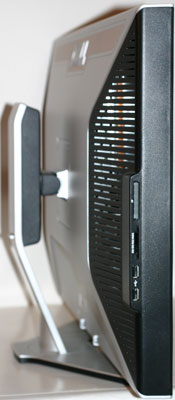 |
| Click to enlarge |
Like the 2405FPW and 2407WFP, the left side provides two additional USB ports along with a flash memory reader. The same flash memory types as the 2407WFP are supported via the 9-in-2 reader.
Describing the On-Screen Display for the 3007WFP is extremely simple: there is no OSD! At the bottom of the display are three buttons: power, increase brightness, and decrease brightness. There are 20 levels of backlight intensity, but there's no immediate indication of your current setting. This is definitely taking minimalism to an extreme, and while many of the other features usually present in an OSD are unnecessary considering there is only one video input available, we really would have liked to see at least a few more options.
Speaking of options, we would also really like to see more video input choices. Granted, no analog signals are going to be capable of driving 2560x1600 resolution without experiencing signal degradation, but the 3007WFP does a good job at scaling non-native resolutions so it still should have been possible to include a VGA connection as well as component inputs and simply limit the maximum resolution with those connections to 1920x1200. We would also really like to be able to run single-link DVI at resolutions above 1280x800.
As it stands, the 3007WFP is intended pretty much only for use with a computer. Considering a 30" LCD is larger than a lot of people's televisions, it seems a shame to limit the versatility of the display.
30 Inch vs. 24 Inch
Having used both of these LCDs for a while, we felt it might be useful to provide our impressions of the experience. We used 21" CRTs for a long time, but the upgrade to a 24" LCD still broght noticeably more screen area. Personally, I held out switching to LCDs due to concerns about refresh rates and pixel response times, but when I finally upgraded to a 24" LCD (the 2405FPW), I was extremely pleased with the result. Some people still have complaints about LCDs versus CRTs, but overall we feel the benefits far outweigh the negatives and all of us are more than happy using LCDs on a daily basis.
If a 24" LCD feels pretty large compared to a 21" CRT (despite the fact that it weighs about one third as much), a 30" LCD is absolutely huge. Provided your eyesight is good enough, you almost feel the need to sit back several feet further away from the computer. Of course, the native resolution is such that icons and text are actually slightly smaller than what they would be on a 24" LCD, and if you end up sitting close to the screen like most people a 30" LCD can almost feel too big.
Another potential problem with such large LCDs is that they can require a ton of graphics power in order to run games at their native resolution. A single fast graphics card like a Radeon X1900 XT is generally sufficient for running most modern games at 1920x1200, but until the launch of the GeForce 8800 series it simply wasn't practical to play most games at 2560x1600 without dual GPUs. Even if you've got the graphics horsepower, configuring some games to run at the native resolution can be a pain, although thankfully this is getting better with time.
24" LCDs are pretty expensive still, and 30" LCDs are even more so, so before going out and spending a lot of money on a large LCD you will definitely want to try one out in person. Provided you have the hardware, using a 30" LCD is a really enjoyable experience for gaming and multitasking, at least from our perspective. Not everyone feels that way, however, and considering the price we feel that the 22"-26" LCDs are currently the sweet spot. You could purchase two 24" LCDs for the price of a 30" LCD right now, and there are also plenty of desks where it simply isn't practical to try and use a 30" display. If you've got the money and desk space, however, a 30" LCD definitely won't disappoint -- it just might take a little time to get used to having such a huge monitor.










62 Comments
View All Comments
Renoir - Monday, March 5, 2007 - link
Yeah I imagine you're right about the dell being able to scale the HDCP content to full screen. Was just wandering given that the review of the http://www.extremetech.com/article2/0,1697,2078203...">HP LP3065 specifically states that it doesn't have a video processor and also suggests neither does the dell 3007. Also the editor spoke to HP after I brought up the issue of HDCP only being supported via single-link DVI which I got from this site http://www.anandtech.com/guides/showdoc.aspx?i=288...">Few paragraphs down and they told him the monitor DOES support HDCP over dual-link. So it would appear that not all lcd's have scalers which is the source of my confusion.TheUsual - Saturday, March 3, 2007 - link
I have experienced the input lag. I had an Acer 24", I think it was the 2416WD. The lag was very noticible when playing UT2004. My brother's 19" Hyundai and my crt had no such problem. Maybe you could find someone on your staff who does notice the lag to report on this aspect.musicalfruit - Saturday, March 3, 2007 - link
How 'bout doing a shootoff between the Dell displays and the Apple Cinema Diplays?The Mac guys at work want ACDs because they're "better" than the Dells. And naturally, I want to save money by buying Dells. Any benchmarks to support either argument would be great!
JarredWalton - Saturday, March 3, 2007 - link
I actually asked for a review sample from Apple a while ago; they declined. I'd like to see if they are any better myself!aixkan - Thursday, March 15, 2007 - link
I have read many comparisons when I worked in Germany 2 years ago – while not perfect, the ACDs consistently were voted the best by the editors of a (neutral) major PC tech magazine (named "c't"), although they always remarked that they were substantially more expensive. Apple does seem to make a good product.I saw a side by side test of a 23" ACD beside the $5000 color calibrated EIZO CG221 at the CeBIT '05. The ACD was obviously not comparable at less than half the price, but you really had to look closely to see the differences.
TheUsual - Saturday, March 3, 2007 - link
My brother has the 1080P Westinghouse TV and I must say the pc looks stunning on it at 1920x1080. I would really like to see a comparison between the Dell 24" and the WH 37". The WH allows you to do PIP with TV and Computer and swap it back and forth. This is a great feature. I was checking out Sony LCDs and I don't believe they support PIP and the new Sharps do now have rbg inputs. So plese, a WH 37" review?orion23 - Saturday, March 3, 2007 - link
Yeah...Loving the new Anandtech with some cool reviews....
I should get my 24-inch Dell LCD by Tuesday / Wednesday of next week, which will replace a Dell 20.1 Inch LCD. Let's see how it does!
asusk7v001 - Saturday, March 3, 2007 - link
Thanks anandtech for a Comparison like thisHowever, for some people like me who want an "All In One" TV/PC monitor which been looking for 2 years now. Recently, there are companies start making 32" 1080p TV. I really would like to see how these TVs compare to PC monitors and some lower resolution
TVs such as 1366 x 768. Lastly, what are the best viewing distance for those TVs as PC monitors
Thanks
hwac
qwerty3788 - Saturday, March 3, 2007 - link
These monitors have a builtin power transformer that is noisy. I had to return my 3007wfp (tried two) because of the noise. If you are working in a silent environment I suggest you buy something else...http://www.hardforum.com/showthread.php?s=d5286df8...">Many others have reported the same problem, so it's not just me.
Zebo - Friday, March 2, 2007 - link
Another issue I have is when you say motion is fine with these and no one will notice. I think everyone will notice this:http://www.veoh.com/videos/v270495J23AR3RZ">http://www.veoh.com/videos/v270495J23AR3RZBetter yet: In your testing..
Try running Titan Quest, kill some enemies and hit the alt key to see what they have laying on the ground after death while you are moving/walking - I bet you can't read what those items are because of the blur with any PVA. You must stop to ID them.
I'm very picky and notice blur 100% of the time even with he fastest LCD's like LCD20WMGX2 and Viewsonics 922 but the PVA's inside the Dell and GW are the slowest tech out and it's not right to tell people they wont notice when most will. Forum thread complaints bear this out.